
ASUS ROG Strix GeForce RTX 4090 D Tweaked to Match RTX 4090 FE Performance
NVIDIA's GeForce RTX 4090 D GPU was launched late last year in China—this weakened variant (of the standard RTX 4090) was designed with US trade regulations in mind. Chinese media outlets have toyed around with various custom models for several months—January 2024 evaluations indicated a 5% performance disadvantage when lined up against unrestricted models. The GeForce RTX 4090 D GPU is a potent beast despite a reduced core count and restricted TDP limit, but Chinese enthusiasts have continued to struggle with the implementation of worthwhile overclocks. HKEPC—a Hong Kong-situated PC hardware review outlet—has bucked that trend.
The mega-sized flagship ZOTAC RTX 4090 D PGF model has the technical credentials to break beyond the expected overclock increase of "2 to 5%," courtesy of a powerful 28-phase power PCB design and 530 W max. TGP limit. The Expreview team pulled a paltry 3.7% extra bit of performance from ZOTAC China's behemoth. In contrast, HKEPC wrangled out some bigger numbers with a sampled ASUS ROG STRIX RTX 4090 GAMING OC graphics card—matching unrestricted variants: "it turns out that NVIDIA only does not allow AIC manufacturers to preset overclocking, but it does not restrict users from overclocking by themselves. After a high degree of overclocking adjustment, the ROG Strix RTX 4090 D actually has a way to achieve the performance level of the RTX 4090 FE."
The mega-sized flagship ZOTAC RTX 4090 D PGF model has the technical credentials to break beyond the expected overclock increase of "2 to 5%," courtesy of a powerful 28-phase power PCB design and 530 W max. TGP limit. The Expreview team pulled a paltry 3.7% extra bit of performance from ZOTAC China's behemoth. In contrast, HKEPC wrangled out some bigger numbers with a sampled ASUS ROG STRIX RTX 4090 GAMING OC graphics card—matching unrestricted variants: "it turns out that NVIDIA only does not allow AIC manufacturers to preset overclocking, but it does not restrict users from overclocking by themselves. After a high degree of overclocking adjustment, the ROG Strix RTX 4090 D actually has a way to achieve the performance level of the RTX 4090 FE."







































